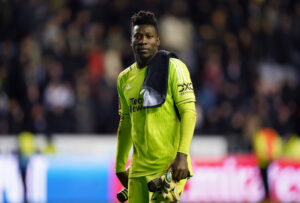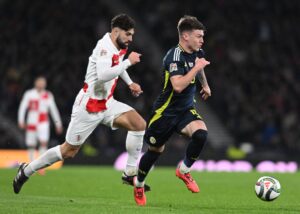Not since the late 1990s has Croatian football been in the position it currently finds itself.
But the fact that Wednesday’s clash with England will mark its second World Cup semifinal match in 20 years speaks to how well-versed in the sport the nation is. That much is certain considering only Germany (4), the Netherlands (3), Brazil (3) and France (3) have more in that span.
You read that right. By virtue of their penalty shootout win over Russia on Saturday, Croatia now has more semifinal appearances since France hosted and won the tournament in 1998 than Argentina, Italy, Spain and its looming opponent. Not bad for a country of slightly over four million people in comparison to those four whose average population comes to 51.7 million.
That 1998 side was a little different from the one who comprises this year’s semifinal quartet. Back then, their success was largely made possible by the greatest target forward in Croatian history, Davor Suker. His six goals that year won him the Golden Boot and accounted for over 50 percent of Croatia’s scoring output. Suker remains his nation’s all-time leading goal-scorer.
How the Croatia Midfield Machine Can Facilitate and Overwhelm in the World Cup Semifinals
Spreading the Wealth
Fast forward 20 years later and Croatia are much more egalitarian when it comes to finding the back of the net. Luka Modric is the only player who’s tallied more than one goal and a total of eight have scored so far. That’s tied with fellow semifinalist Belgium for most players on a single team at this year’s World Cup.
What’s telling about that fact is that teams who share the scoring load have historically realized great success at this tournament. Of the 20 World Cup winners, a whopping 17 finished no worse than third in terms of how many players registered at least a goal. For those hoping to see a matchup between teams looking to hoist the trophy for the first time, that stat is music to their ears.
From the perspective of this year’s Croatia squad, this indicates that a dynamic midfield which includes Modric and Ivan Rakitic is firing on all cylinders. The club-country dynamic between these two is as intriguing as any at the World Cup with the two part of the famed Real Madrid-FC Barcelona rivalry. But they complement each other well for their country and their ability to link up with the attack and contribute to it themselves is a huge reason Croatia’s still here.
Against England, their chance creation exploits need to continue. Modric’s 14 key passes are third best at this year’s World Cup and Rakitic has added seven which is second best behind his club rival on the team. From a tactical standpoint, they may have an advantage from the standpoint of creating danger in the final third.
A Potentially Critical Weakness in England’s Formation Croatia Can Pounce on
Sometimes the term “jack of all trades” carries with it a negative connotation. That’s because it oftentimes gets qualified with “master of none.” But in the case of the midfield partnership that is Modric and Rakitic, they truly succeed in a variety of situations. And in football as well as other team sports, versatility can set you apart from the pack in many respects.
But it takes an astute manager to make the most of their do-everything nature. In Zlatko Dalic, they have such a figure. In the group stage opener against Nigeria, he had them sit in a more withdrawn defensive role to counteract their opponent’s athleticism in the attack. When they took on Argentina five days later, they were deployed much higher up the field in an attempt to win the ball in advanced positions. It played a part in one of the most dominant displays of this tournament.
Having said this, Dalic kind of got it wrong against Denmark. If not for the PK triumph, it would’ve resulted in an early exit. Too often did Croatia overly try to create pressure from out wide instead of relying on what their midfield can do centrally. The heat map from the game, which tracks where touches of the ball occurred most frequently, points this out in stark fashion.

This simply can’t happen in Moscow on Wednesday if Gareth Southgate stays true to form. In all five of England’s games, he’s set the Three Lions up in a 3-1-4-2 shape that, for all its attack-minded benefits, has one key weakness. It forces Jordan Henderson to cover a lot of ground in front of what essentially becomes a back five when the opposition possesses the ball in their defensive third.
How to Exploit It
What transpired against Argentina is likely the template to follow against England. Let Marcelo Brozovic sit deep and allow Modric and Rakitic to utilize their defensive work rate and playmaking ability further up the field. That will allow them to pick out spots in the half spaces close to the England goal to facilitate attacking opportunities. Assuming Southgate makes no adjustments to his tactics, a proactive style when the Three Lions have possession will, in all likelihood, produce success.
But it won’t be easy. Croatia has endured a grueling knockout stage that has included 240 minutes of regulation and extra time football combined with two penalty shootouts. The mental and physical grind associated with it surely has taken its toll. That said, England had its own Russian roulette live or die situation against Colombia in the round of 16. Though they exorcised some long-standing demons in the process, there is the possibility of them resurfacing once more. And Croatia remains undefeated all-time in World Cup penalty shootouts should it come to that.
The fact remains that Croatia boasts two of the most multifaceted midfielders on the entire planet. It’s an ostensibly unique partnership. Though they’re devoted teammates who beam with pride when the national anthem plays, they’re strident enemies when their two clubs do battle. The camaraderie associated with the former will emerge on Wednesday at the Luzhniki Stadium. And should they emerge victorious, the prospect of an unprecedented national achievement remains genuinely attainable.






